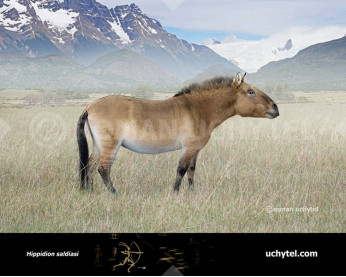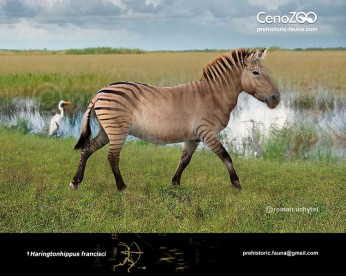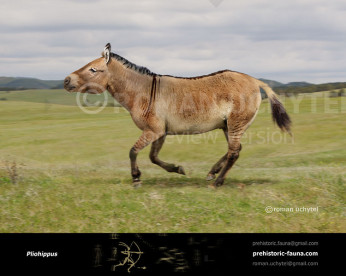Amerhippus
547547
Amerhippus (†Equus andium (Branco, 1883))
Order: Perissodactyla
Family: Equidae
Genus: Equus
Subgenus: †Amerhippus (Hoffstetter, 1950)
Expansion: late Pleistocene of South America (2.588 to 0.012 Mya )
Dimensions: 2,5 m in length, 150 cm in height, 400 kg of weight
Amerhippus is an extinct South American horse of uncertain taxonomic identity in the genus Equus. It is sometimes classified as a subgenus containing several extinct species of horses that lived in South America, or a single, morphologically variable extinct species Equus neogeus.
They were one of two groups of equines in South America alongside Hippidion. Fossils have been recovered from the Tarija Formation of Bolivia, the Serranía del Perijá in Venezuela, the Chiu-Chiu Formation of Chile, the Sabana Formation of the Bogotá savanna in Colombia, and from various locations in Ecuador.
While they have formerly been referred to as belonging to 5 separate species, this has been revised down into three, and more recently a single, morphologically variable species Equus neogeus. Equus first appeared in South America during the late Early Pleistocene around 1 Ma. A 2008 study of mitochondrial DNA fragments of a specimen of E. neogeus found it to be nested within mitochondrial lineages of E. caballus. A close relationship to caballine horses was also supported by a 2019 morphological analysis study.
Оплата
У Вас є кілька зручних способів купівлі зображення: кредитна чи дебетова картка Visa, Mastercard, Maestro; PayPal або банківський переказ
Amerhippus (†Equus andium (Branco, 1883))
Order: Perissodactyla
Family: Equidae
Genus: Equus
Subgenus: †Amerhippus (Hoffstetter, 1950)
Expansion: late Pleistocene of South America (2.588 to 0.012 Mya )
Dimensions: 2,5 m in length, 150 cm in height, 400 kg of weight
Amerhippus is an extinct South American horse of uncertain taxonomic identity in the genus Equus. It is sometimes classified as a subgenus containing several extinct species of horses that lived in South America, or a single, morphologically variable extinct species Equus neogeus.
They were one of two groups of equines in South America alongside Hippidion. Fossils have been recovered from the Tarija Formation of Bolivia, the Serranía del Perijá in Venezuela, the Chiu-Chiu Formation of Chile, the Sabana Formation of the Bogotá savanna in Colombia, and from various locations in Ecuador.
While they have formerly been referred to as belonging to 5 separate species, this has been revised down into three, and more recently a single, morphologically variable species Equus neogeus. Equus first appeared in South America during the late Early Pleistocene around 1 Ma. A 2008 study of mitochondrial DNA fragments of a specimen of E. neogeus found it to be nested within mitochondrial lineages of E. caballus. A close relationship to caballine horses was also supported by a 2019 morphological analysis study.

-andium-797x638.jpg)

-346x277.jpg)


